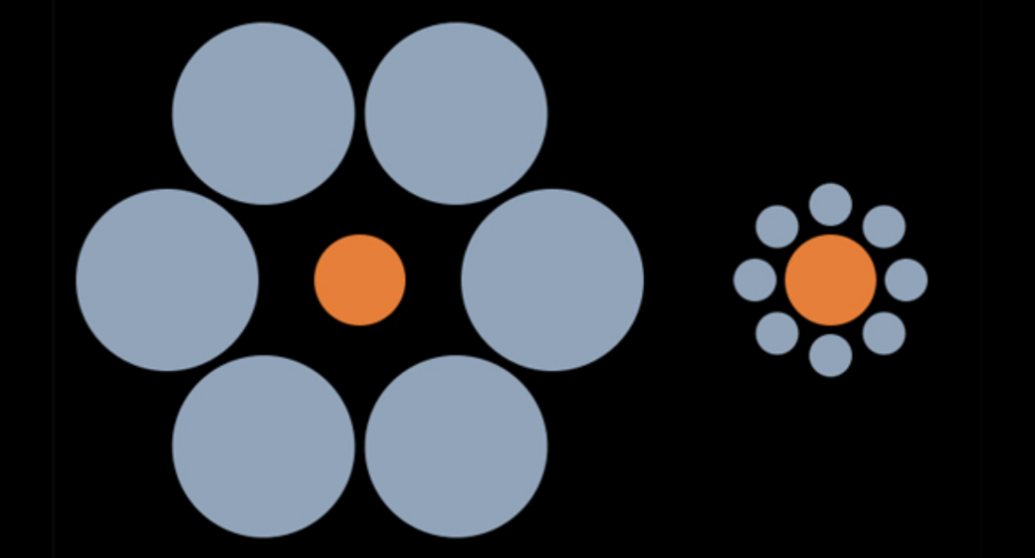Dear Gemba Coach,
How do I implement 5S in our small but growing shop where operators have the belief that everyone does things a little differently?
Everyone always does everything a little differently. That’s the point. A goalpost of successful 5S is that anyone should locate what is needed – a tool, a part, a document – with their eyes closed. But the real aim of 5S is getting the team to come together on routines that support smooth and seamless standard work.
Let’s take a looong step back. How do these two orange circles compare?

You can look at these other great illusions from Dr. Pascale Michelon. Or ask yourself which of these two lines is longer:

This one is straight out of Taiichi Ohno’s Workplace Management book – right in the beginning.
When you look at illusions such as these do you feel that:
- Your brain is tricking you into false beliefs.
- Your brain is working perfectly and you’ve tricked it.
The answer is 2. Your brain is working perfectly to interpret the world out there and you’re tricking it by putting it in unusual and rare conditions. The point is there is reasoning in thinking.
We tend to think that we see, then we interpret. But the truth is that we interpret as we see. There are all sorts of cognitive stuff happening during vision and, actually, 2/3rds of the brain is involved in vision with up to 30% of the cortex dedicated to it (as opposed to 8% for touch and 3% for hearing).
Seeing Really Is Believing
Because there is no filter on vision, we believe what we see, instantly and unquestioningly. That is why clarifying a visual presentation is so important. When you start looking at something you’re already thinking about it. The important point here is that you won’t be reasoning the same visually as you’d do through touch or language.
Lean has a long tradition of this, and my father’s sensei quotes his own sensei in saying:
“Use feet/hands/eyes to see the true facts with genchi genbutsu by yourself :
- Don’t ask men! Ask things
- Don’t see by your eyes! Watch by your feet!
- Don’t think by your brain! Think by your hands”
The upshot is that how elements of work are visually positioned has an impact on how work is done and how we think about it.
The second mechanism to consider is habituation. When we do something repetitive, the brain imprints it and stops thinking about it. Your hands open the drawer to find the tea spoons without thinking – and you’ll start thinking again if they’re not there. Again that makes sense, we clearly don’t want to have to think about everything all the time.
The downside of habituation is that we lose sight of weak signals and tend to proceed as if everything is normal even if there are signs something is out of joint – which mostly leads us into trouble later.
5S is a method to get the team to converge on the best visual environment to work effectively. It’s not something you implement, it’s a method you teach. It’s not something you do to them, it’s a discipline they learn. In lean, we have two main visual tools:
- 5S, which is habit forming – we want the right things in the right place to work smartly.
- Kanban, which is habit breaking – we need to follow the kanban and make sure every delivery to kanban has the right quality, which requires attention, questioning, and thinking.
5S is a method to get the team to converge on the best visual environment to work effectively. It’s not something you implement, it’s a method you teach. It’s not something you do to them, it’s a discipline they learn.
Seeing Is Reasoning
Think of 5S as a “purification of space” method. After a job is done, and then during the job, bring back the work environment to its clean form. You train to:
- Sort (Seiri): Looking at the workplace and spotting clutter. Again, looking for clutter is thinking about clutter – looking is reasoning. By looking at clutter you think about it, wonder why it’s there and discuss it with your colleagues.
- Set in order (Seiton): Agreeing on the right place for each thing means having a clear understanding of the sequence of work in which we need things. Yes, if people don’t work the same way they’ll need them at different spots, which is precisely the aim of the exercise. Seiton should lead us to discuss how we work and what is the best arrangement to support it.
- Shine (Seiso): Cleaning tools right after you’ve used them and setting them back at their seiton place is about care – and inspection – of what you need to work. Think of it as purifying the work environment from the previous work cycle and bringing everything to pristine order. You’ll be surprised to see how satisfying this is. Seiso changes your relationship to work and opens your eyes to things that need fixing now before they create an incident.
- Standardize (Seiketsu): Creating the team routines to keep the workplace in order is an essential part of the practice. When do we do the previous 3Ss? At the end of the day? Once a week? After every job? All of them? Learning to work together is about establishing work rituals which serve as reference points for team members and as team-building activities.
- Sustain (Shitsuke): Supporting and auditing by management of the preceding 4Ss to demonstrate commitment to a safe and clean workplace and to help teams with concrete problems (such as needed tools) that’s they don’t have the autonomy for.
5S is powerful precisely because everyone does things a little differently. Creating a culture of quality rests on, first, having high standards for quality and illustrating it through daily behavior of not letting poor quality pass. But it also rests on collective routines to establish quality. Self-inspection is one such set of routines, but 5S, the control of the conditions for quality is another key one.
5S is not about creating the perfect workspace on paper and implementing it. It’s a self-study and self-development method for the team to come together…5S is not about creating the perfect workspace on paper and implementing it. It’s a self-study and self-development method for the team to come together on having things exactly as they want them, where they want them. Taught properly, 5S will bring the team together on common norms about how they do the work and standards of “what is a good job.”
Rather than “implement” 5S, the real questions to ask as you grow are:
- Are there clear teams?
- Does each team have a team leader?
- Is this team leader trained at using 5S to make his team come together?
- Are the teams’ physical arrangements supporting standardized work?
Looking is thinking. A unique aspect of lean is understanding the huge part visualization plays in seeing the ideal, spotting waste and problems, and resolving situations astutely. 5S is the first step into this form of thinking – it can’t be implemented. It can only be taught.
For more information on 5S, check out its Lean Lexicon definition page.






